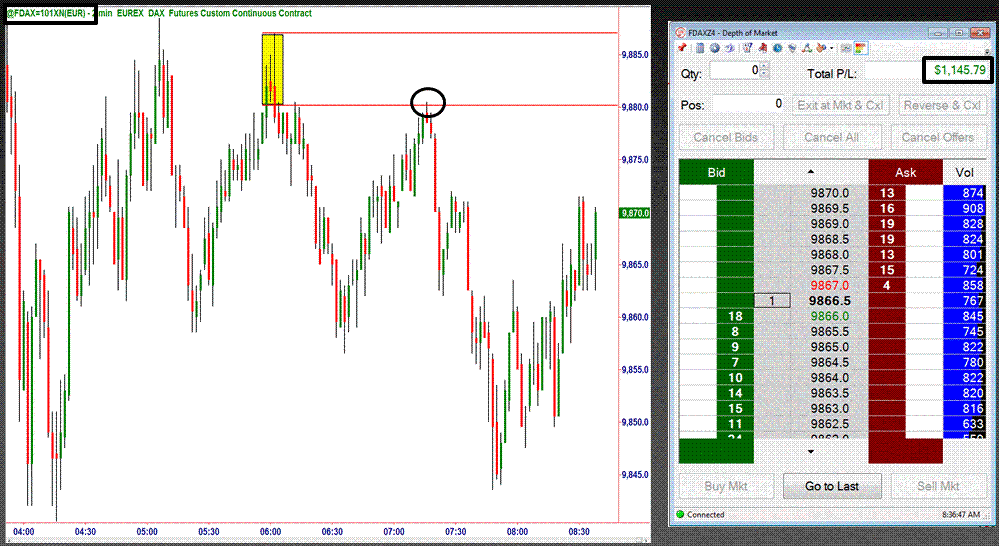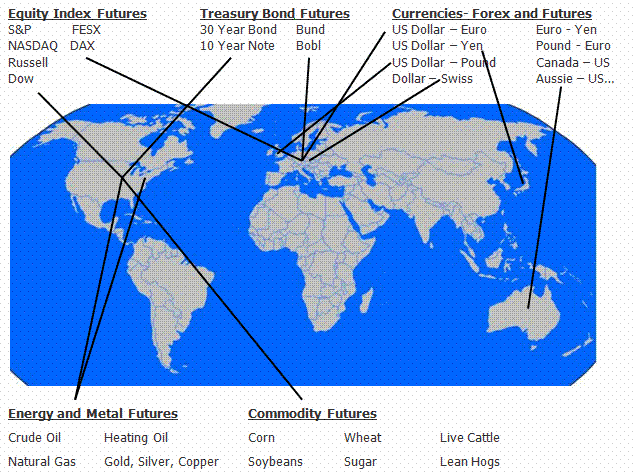![]()
When it comes to the trading different asset classes, I get more questions about the Futures markets than any other set of markets. This is because many people hear from others how great these markets are for short term income and long term wealth trading but know very little about them. In my opinion, these are some of the greatest trading markets in the world. They have many benefits that other asset classes don’t and I will bullet those points for you here.
Benefits of the Futures markets:
No $25,000 minimum day trading requirement like you have in Equities if you live in the USA
Plenty of leverage, low margin requirements
Most futures markets have close to around the clock trading
Low commissions
Only set of markets in the world where you have true non-correlated/diverse opportunity which is key for managing risk
Little overnight gap risk like you have in Equities
Huge volume, overnight Electronic trading
60/40 Long term capital gains tax treatment if you live in the USA
How do you trade Futures?
To answer this question, let’s look at a trade right out of our live trading program.
DAX Futures, Income Trade – Wednesday December 10, 2014
During one of our trading and analysis sessions, we identify a supply level with no strong demand below. This was a price level where the chart told me there was more willing supply than demand. This is exactly where we want to enter our trades as the risk is lowest, reward is highest, and the probability of the trade working is strongest. In the DAX trade here, I identified a supply level and waited for price to rally up to that level where I was interested in taking a short position. I was simply selling to someone who was buying after a rally in price and at a price level where the chart was telling me supply exceeded demand. In other words, I was selling short to a novice buyer. Futures trading is a zero sum game. The traders that know what they are doing get paid from those who don’t. The lack of demand below meant there was room for price to decline which it did, after entry. When you sell short in futures, you simply push the button. There never was an “uptick” rule. These trades are all done electronically. When you trade the S&P (E-Mini) for example, you are trading it on the Globex system which is the Chicago Mercantile Exchange’s electronic order matching system.
What about margin and leverage?
Often, when I mention the words Futures and leverage together, people want to run because they think it’s very high risk. That is not true at all. If you use and adhere to your protective stops, the futures become one of the lower risk asset classes for two reasons. First, the huge volume in the Futures markets we trade means very little slippage compared to other asset classes. Second, most of the Futures markets we trade are open close to 24 hours a day which means your overnight gap risk does not exist like it does in some other asset classes.
Online Trading Academy offers its students global opportunity when it comes to short term and longer term speculating in Futures markets. This means true diversification. Most investors have their portfolio split between equities and bonds. What most people don’t realize is that there are two major problems with this approach. First, no matter how diversified the equity portion of your portfolio is, global equity markets typically move in the same direction. Instead of diversifying across global equity markets based on supply and demand (proper market timing) to decrease portfolio risk, this approach actually increases risk, but most investors never realize this until it’s too late. This type of investing also requires global equity markets to increase in value for the investment to appreciate. Once again, this is high risk investing as markets can decline for long periods of time, such as Japan’s multi-year equity meltdown years ago. The main point is, if your retirement money is at risk of decreasing if the market you’re invested in falls you may want to rethink that, there are much safer ways to invest and limit or eliminate downside risk.
Being a Futures trader and a Futures XLT instructor, one of the most enjoyable aspects of my daily routine is scanning the global markets with students for the low risk/high reward opportunities we require for trading. We focus on pure supply and demand as seen in the price action (candles) alone. We don’t have different strategies for different markets or different market environments. We simply apply one high probability strategy across global correlated and non–correlated markets. This means finding markets around the globe where supply and demand are out of balance and simply trading them back to balance. Students understand that their job as an active trader is not to wake up each morning and trade, it’s to wake up each morning and apply our rules to look for low risk, high reward, and high probability trading opportunities. When we find them we take rule based action and trade. When we don’t find them, we don’t trade. We always have a mix of income and wealth trades as well as longer term position trades when they arise. We move from country to country and continent to continent with the push of a button searching for our picture of low risk, high reward, and high probability trading opportunity, and it is truly a fun experience.
When I began trading from home many years ago, I was amazed at the fact that I had the ability to trade the global markets from my fingertips. These days, it’s even more amazing as new markets have come on the scene. Volumes are huge, commissions are low, and the playing fields are more level than they have ever been, and so on. It’s great to be a trader. Below are some (but not all) of the markets we learn about, analyze, and trade in the Futures Program:
With our focus on quantifying supply and demand across global markets and a team of students and instructors scanning for imbalances (opportunity), it is really amazing where globalization has taken us. Our live trading program (XLT) is for those who are serious about attaining an edge in the markets. Much like the XLT, the Futures markets are only for serious traders. They are certainly not complicated markets to trade. In many ways they are structured in a very simple way with few, yet important rules and regulations compared to other asset classes. Whatever market you are trading, make sure you first and foremost learn how to trade. Each time you push the button to buy or sell, there is someone on the other side of your trade trying to take your hard earned money. On the trade above, I made a profit of $1,145.00. This money was made because of an edge that allows the student and I to get paid from those who don’t have that edge. It would be great if everyone could profit in trading all the time, but that’s not how the world works unfortunately. This piece was not in any way intended to suggest that trading is easy. The rules and logic behind our core strategy are very simple. However, “doing it” is not easy, as proper trading can be emotionally challenging to the average person at first. The key to overcoming this is a strategy that is based on a mechanical set of objective rules.
Hope this was helpful, have a great day.
Note: All information on this page is subject to change. The use of this website constitutes acceptance of our user agreement. Please read our privacy policy and legal disclaimer. Opinions expressed at FXstreet.com are those of the individual authors and do not necessarily represent the opinion of FXstreet.com or its management. Risk Disclosure: Trading foreign exchange on margin carries a high level of risk, and may not be suitable for all investors. The high degree of leverage can work against you as well as for you. Before deciding to invest in foreign exchange you should carefully consider your investment objectives, level of experience, and risk appetite. The possibility exists that you could sustain a loss of some or all of your initial investment and therefore you should not invest money that you cannot afford to lose. You should be aware of all the risks associated with foreign exchange trading, and seek advice from an independent financial advisor if you have any doubts.
Editors’ Picks
EUR/USD stays below 1.0700 after US data

EUR/USD stays in a consolidation phase below 1.0700 in the early American session on Wednesday. The data from the US showed a strong increase in Durable Goods Orders, supporting the USD and making it difficult for the pair to gain traction.
USD/JPY refreshes 34-year high, attacks 155.00 as intervention risks loom

USD/JPY is renewing a multi-decade high, closing in on 155.00. Traders turn cautious on heightened risks of Japan's FX intervention. Broad US Dollar rebound aids the upside in the major. US Durable Goods data are next on tap.
Gold manages to hold above $2,300

Gold struggles to stage a rebound following Monday's sharp decline but manages to hold above $2,300. The benchmark 10-year US Treasury bond yield stays in the green above 4.6% ahead of US data, not allowing XAU/USD to gain traction.
Worldcoin looks set for comeback despite Nvidia’s 22% crash Premium

Worldcoin price is in a better position than last week's and shows signs of a potential comeback. This development occurs amid the sharp decline in the valuation of the popular GPU manufacturer Nvidia.
Three fundamentals for the week: US GDP, BoJ and the Fed's favorite inflation gauge stand out Premium

While it is hard to predict when geopolitical news erupts, the level of tension is lower – allowing for key data to have its say. This week's US figures are set to shape the Federal Reserve's decision next week – and the Bank of Japan may struggle to halt the Yen's deterioration.
RECOMMENDED LESSONS
Making money in forex is easy if you know how the bankers trade!
Discover how to make money in forex is easy if you know how the bankers trade!
5 Forex News Events You Need To Know
In the fast moving world of currency markets, it is extremely important for new traders to know the list of important forex news...
Top 10 Chart Patterns Every Trader Should Know
Chart patterns are one of the most effective trading tools for a trader. They are pure price-action, and form on the basis of underlying buying and...
7 Ways to Avoid Forex Scams
The forex industry is recently seeing more and more scams. Here are 7 ways to avoid losing your money in such scams: Forex scams are becoming frequent. Michael Greenberg reports on luxurious expenses, including a submarine bought from the money taken from forex traders. Here’s another report of a forex fraud. So, how can we avoid falling in such forex scams?
What Are the 10 Fatal Mistakes Traders Make
Trading is exciting. Trading is hard. Trading is extremely hard. Some say that it takes more than 10,000 hours to master. Others believe that trading is the way to quick riches. They might be both wrong. What is important to know that no matter how experienced you are, mistakes will be part of the trading process.


